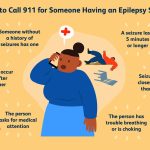A seizure can happen suddenly and can be frightening to watch. The person may lose control of their body, fall, shake, or become unaware of their surroundings. Even though seizures look scary, most last only a few minutes. In many cases, simple and calm actions from bystanders can keep the person safe. Knowing what to do helps you stay steady and avoid mistakes that could harm the person. Learning these steps prepares you to support someone until the seizure ends and they can recover.
Why Understanding Seizures Helps You Respond Better
Many people have never seen a seizure before and feel unsure about how to help. Some may panic or try to hold the person down. Others may try unsafe actions because they think they are helping. Learning how seizures work helps remove fear and gives you confidence in knowing the right steps.
A seizure happens when there is sudden electrical activity in the brain. It can affect movement, behavior, or awareness. Some people have medical conditions that cause seizures, while others may experience one after an injury or illness. No matter the reason, quick and calm support makes a big difference.
Staying Calm and Making the Area Safe
When a seizure begins, the first and most important step is to stay calm. Your calm behavior helps you think clearly and respond the right way. The next step is to keep the person safe by clearing the area around them. This helps prevent injuries caused by sharp or hard objects.
You can do this by:
• Moving furniture away
• Taking sharp items out of reach
• Removing glasses gently
• Placing something soft under their head
These simple steps reduce the chances of the person hitting their head or hurting themselves while the seizure continues.
Avoiding Dangerous Actions During a Seizure
Some people believe they should hold the person down during a seizure, but this is not safe. Trying to stop the movements can cause injuries to both you and the person having the seizure. The body moves on its own during this time, and the seizure must run its course.
There are also myths about putting something in the person’s mouth to stop them from swallowing their tongue. This is not true. You should never put anything in their mouth during a seizure. This can block the airway or cause injury to the teeth and mouth.
Safe things to avoid include:
• Do not hold the person down
• Do not put anything in their mouth
• Do not give food or water
• Do not try to stop the movements
Avoiding these mistakes protects the person and keeps you safe as well.
Watching the Length of the Seizure
Timing the seizure is very important. Most seizures last one to three minutes. They may feel longer, but using a watch or phone timer helps you stay accurate. Knowing the length helps medical teams understand the situation better if help is needed.
Call for emergency help right away if:
• The seizure lasts longer than five minutes
• The person is injured
• The person has trouble breathing after the seizure
• The person has another seizure soon after the first
• The person is pregnant or has a known medical condition
These signs mean the person may need medical care quickly.
Staying With the Person Until the Seizure Ends
After the seizure starts, stay with the person and watch them closely. You do not need to do much during the seizure itself. Just stay near them and make sure the area stays safe. Take slow breaths and stay patient. The seizure will usually stop on its own.
When the movements stop, the person may be confused, tired, or unable to speak right away. This is called the recovery stage. They may not remember what happened. Your support during this time helps them feel calm and safe.
Helping the Person After the Seizure
Once the seizure ends, gently turn the person onto their side if they are not already in that position. This helps keep the airway open and prevents choking. Check their breathing. Most people start breathing normally again after the seizure is over.
Stay with them and offer simple comfort:
• Speak softly
• Tell them they are safe
• Give them time to recover
• Help them sit up slowly when ready
Some people may want to rest. Others may feel embarrassed or confused. Your calm support helps ease their stress.
Watching for Signs That Need Medical Attention
Even though many seizures end safely, some signs mean the person needs medical help. Knowing these signs helps you make the right choices.
Call for help if:
• Breathing does not return to normal
• The person stays unconscious too long
• The person is injured from falling
• The person has trouble waking up
• The seizure happened in water
These situations can place the person at higher risk and require professional care.
Common Mistakes and How to Avoid Them
During emergencies people often act out of fear or confusion. This can lead to mistakes that put the person in more danger. Knowing the most common mistakes helps you avoid them.
Mistakes to avoid include:
• Trying to shake the person awake
• Pouring water on them
• Giving medicine during the seizure
• Panicking and leaving them alone
• Trying to hold their tongue
Understanding what not to do is just as important as knowing what to do. Many people learn the right steps through simple training resources such as MyCPR NOW which help build confidence in handling emergencies.
Keeping Yourself Safe While Helping
Helping others is important, but your safety matters too. Do not place yourself in danger. If the area is unsafe or crowded, move the person only if you must. When possible, protect your hands and stay aware of your surroundings.
You can protect yourself by:
• Staying a safe distance from sharp objects
• Moving slowly and carefully
• Avoiding placing your fingers near the mouth
• Asking others nearby to assist with clearing space
Your safety helps you stay focused and ready to give proper care.
Why Training Builds Confidence for Seizure Care
Learning skills through proper training helps you respond with confidence. When you understand how seizures work and what steps to take, the fear of the unknown becomes smaller. Many people choose simple and clear online training from places such as MyCPR NOW to help them understand emergency care in an easy way.
Training gives you benefits like:
• Knowing how to stay calm
• Understanding safe steps
• Feeling ready to act
• Reducing panic during real events
These skills help you protect others in ways that are safe and effective.
Conclusion
A seizure can be a stressful moment, but your calm and careful actions can help keep the person safe. By making the area clear, avoiding dangerous actions, timing the seizure, and staying with the person, you give the support they need until the episode ends. Helping them recover afterward with gentle care and simple steps can make a big difference.
Training and practice help people feel more confident about responding. Many learn these important skills through trusted online education such as MyCPR NOW and feel more prepared to help during emergencies. With simple knowledge and calm action, anyone can make a positive difference when someone experiences a seizure.










